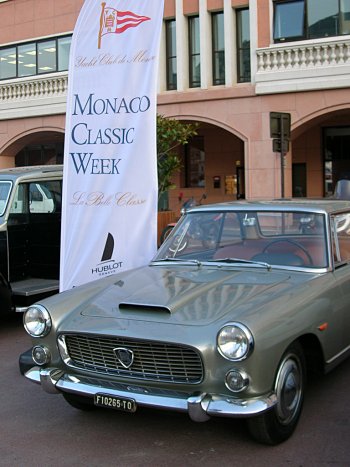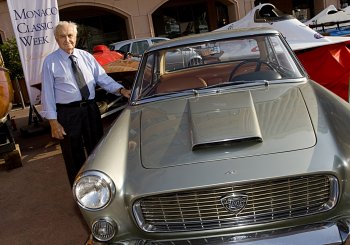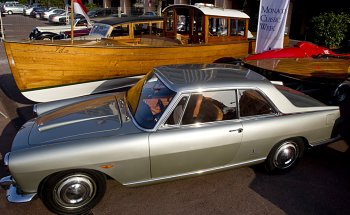|
First produced
in 1957, the great Lancia Flaminia flagship was one of the most admired cars of
its time and even today, the 337 Cabriolet Presidenziale is still used as an
official limousine by the President of the Republic in Italy for official duty.
Over the last week the Flaminia has celebrated this milestone during Monaco
Classic Week.
A luxurious, imposing car, produced right up to 1970 in three successive series
– especially captivating the coupé by Pininfarina, the Touring and the Zagato –
the Flaminia is perfectly at ease in the Lancia tradition for stylistic and
engineering excellence, in spite of the fact that it is introduced in the
mid-fifties, a transition period for the Turin-based Company of Borgo San Paolo.
Gianni Lancia, heir to Vincenzo, relinquishes control of the Company to Carlo
Pesenti at the end of 1955. In that very year, in March exactly, Antonio Fessia
becomes chief design engineer replacing the charismatic Vittorio Jano.
Immediately, the new management makes an important decision, namely to build a
replacement for the Aurelia as the flagship model. In 1955 Antonio Fessia, an
ingenious world-famous designer, is entrusted with the creation of the new car,
champion of the Italian sedan.
Fessia, whose curriculum includes the Fiat 500 Topolino and the Cemsa Caproni of
1949, decides to start from the 60°, 6-V cylinder engine. Designed by Francesco
De Virgilio for the Aurelia, it proved its worth, the objective being to further
improve performance. Simultaneously, Fessia asks Pininfarina (still known as
Pinin Farina at the time) to develop a new body. The outcome of this work is
delivered merely six months after initial design, when the Flaminia prototype is
exhibited at the Turin Motor show in 1956.
The Aurelia and Florida connection
The solutions adopted are of great interest. Fessia has sized down the Aurelia
powerplant, adopted the square configuration of the boxer instead of the long
stroke solution. The new engine delivers 100 HP at 4,800 rpm approx., which is
adequate for an important car whose main assets are to be above all flexibility
and quiet running. Of the Aurelia there remains the transaxle with rear mounted
powerplant (clutch-transmission-differential), moving away from the 35-year old
independent front suspension system originally introduced on the Lambda, to opt
for a new layout with telescopic struts, parallelogram arms, coil springs and
stabiliser bar.
As regards body design, the new Lancia management was very keen on the Florida,
one of the latest Aurelias created by Pinin Farina. It was a two-door and
four-door sedan (front and rear hinged), offering plenty of light, with
continuous side glazing and roof blending with the tail through a pair of ‘fins’
emerging from the sides. Pinin Farina’s terms of reference were to design the
new car based on the lines of the of the Florida. Therefore, he proposes a low,
streamlined but imposing solution. The Flaminia does away with a number of
stylistic details by then typical of the Lancia design, such as front-hinged
front doors and rear hinged rear doors and shield-like front grill. Others were
left to provide continuity. Out of all these details, the one giving a clear
separation between top and bottom, further enhanced on the two-tone versions, is
door and glazing symmetry. The final version comes with a solution (new for
Lancia) featuring rear hinged doors front and rear with a centre post. Interior
finish is superbly elegant, riding comfort reaches new heights, never attained
before on Italian cars.
From 1956 to 1970, the three series of the sedan
After the preview of 1956, the Flaminia is officially presented the following
year at the Geneva Motor Show, with few changes compared to the prototype. It is
the greatest, most luxurious Italian car at that time, and expectations from it
are high indeed, encouraged by a strong demand and favourable comments of the
press. Initially, production rate at the Borgo San Paolo plant is seven to eight
units a day, incorporating at the highest quality standards Lancia could offer
at the time. In the first four years, 2.695 first-series specimens were
produced, of which 41 Saxomat with semi-automatic clutch and 31 units as a
variant, also with semi-automatic clutch, for the US market.
The second series of the Flaminia is presented at the Turin Motor Show in 1961.
The compression ratio is increased, the engine is more powerful (110 HP against
the previous 102), the top speed goes up (to 167 km/h) and disc brakes are
installed on all four wheels. Style is virtually unchanged. Minor cosmetic
changes affect only the tail lamp units to include a backup light. Inside the
vehicle, the instrument panel features revised air outlets and new turn signal
tell-tales. A new version, the Speciale, is introduced in 1962, with engine
upgraded to 140 HP and top speed of 180 km/h.
Finally, the third and last series, the 2.8 with a 129 HP engine, is unveiled at
the Frankfurt Motor Show in 1963. The body continues unchanged.
|
 |
|
A luxurious, imposing car,
produced right up to 1970 in three successive series
the Flaminia is perfectly at ease in the Lancia
tradition for stylistic and engineering excellence. |
|
|

 |
|
Regarded by many as one of the finest designs of all
time, the famous Lancia Flaminia is celebrating its
50th anniversary this year, and this week it has
been centre stage at Monaco Classic Week. |
|
|
The only distinguishing feature is the “2.8” motif next to
the Flaminia logo on the trunk lid above the registration
number plate. It will continue in production until 1970. In
total, about 4,000 Flaminia sedans were produced. It’s not a
lot, but they contributed to the world car history a model
arguably unequalled in terms of elegance and refinement.
1958, the year of the coupé
At the Turin Motor Show of 1958, Pinin Farina presents an
elegant prototype, subsequently volume produced starting
from the following year. It is a four-seater with pleasing
flowing lines, and wheelbase reduced by 12 cm. A more
powerful engine (119 HP against 102) and a lighter weight
make for increased top speed (170 km/h against 160 of the
sedan). This model is still today considered one of the best
ever created by the Turinese stylist.
Same year, same venue: The Turin Motor Show. Touring
exhibits the Gran Turismo version of the Flaminia, with an
ever shorter wheelbase than Pinin Farina’s coupé. It is a
two-seater of brilliant performance thanks to its
super-lightweight body which, for the same 119 HP, gives a
top speed of 180 km/h. Same year, same venue, more coupés:
visitors at this magic edition of the Turin exhibition have
the privilege of admiring the Flaminia Sport by Zagato.
Decidedly sporty (top speed 190 km/h), it is reminiscent of
the lines of the coupé Appia GT (also by Zagato), above all
for the undulated top. The Super Sport version will be
produced in the following years, featuring revised body and
interior, with a top speed of 210 km/h, a record as the
fastest production Lancia which will remain unbeaten for
quite sometime. The Flaminia Convertible, one of the most
attractive open tops of its time, appeared in 1960. This is
a spider 2+2 developed from the GT by Touring, with a 2.5
engine, subsequently modified to incorporate three
carburettors, and a 2.8.
The limousine for Presidents
In order of time, the latest President to have used it is
Giorgio Napolitano at the parade of June 2, 2007, but
Presidents of Italy and the Lancia Flaminia have fifty years
of shared history, since in March 1960 the Quirinale ordered
four special version Lancia Cabriolet Presidenziale
limousines. Pinin Farina designed them within six months, to
the personal specifications of the incumbent President,
Giovanni Gronchi. About five and a half meter long and
weighing two tonnes, these cars can carry seven passengers,
two of whom on comfortable folding leather seats. The 2.5
engine is the same as that of the production sedan (with
extra electric pump and coil), wheelbase being 3.350 mm
against the 2.870 of the production model. All the rest,
from the power operated top to the last detail, was totally
hand-made. Top speed does not exceed 120 km/h because of the
reduced axle ratios (10/47 against 12/47), especially
designed for ceremonial crawling speeds without declutching.
The four Flaminia 337 Cabriolet Presidenziale were
christened with the names of horses, namely Belmonte,
Belvedere, Belfiore and Belsito. Only the last two are
currently parked in the garages of the Quirinale. The
Flaminia Presidenziale continues to inspire respect and
admiration. At the time it was the only Italian antagonist
to foreign ceremonial limousines. Its first official duty
took place in 1961, on the occasion of the State visit to
Italy by Queen Elisabeth II, coinciding with celebrations
for the centenary of the Unification of Italy. In 1982,
during Sandro Pertini’s Presidency, two Flaminias were sold
at a ridiculously low price during a military auction. After
years of dedicated service, without ever a breakdown thanks
to the care of the technicians of Via della Dataria, time
came to say goodbye.
However, a sudden change of scenery was awaiting. During the
first tour of honour by President Francesco Cossiga, the car
selected had a breakdown, and the Belfiore was brought back
in service, thereby preventing the Flaminia 337 Cabriolet
Presidenziale from being sold off. Also President Oscar
Luigi Scalfaro rode the Flaminia during official events. And
the same applies to President Carlo Azeglio Ciampi, who on
June 2nd would inspect the guard at the Vittoriano on board
the ever-lasting Lancia.
Today, the Flaminia 337 Cabriolet Presidenziale limousines
at the service of the President are in perfect health. The
shiny original dark blue paintwork perfectly matches the
Connolly 8500 black leather interior, and the original
vintage Voxson car radio is there too. By the way, on
October 16, 2000, when Queen Elisabeth II returned to Italy
on her third visit to the Country, Her Majesty was welcomed
once again with the Flaminia, queen of automobiles.
|
|
|
|